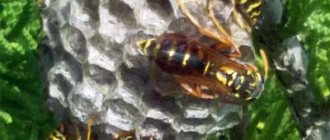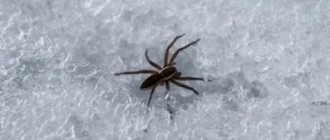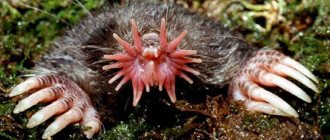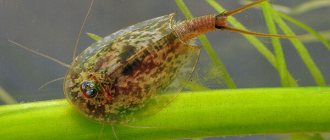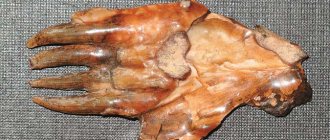Home Rodents Features of mole wintering
In order to protect the harvest in the future and properly organize protection from these animals in the garden or garden, it is useful for farmers to learn how moles overwinter. After all, many owners of dachas and household plots mistakenly believe that moles, which have become boring during the summer and autumn, go into hibernation in the winter, since there is nothing to harm - the harvest has been harvested.
But in fact, they continue their activities even in cold weather.
- Let's get to know the digger better
- Are there any benefits from these animals?
- The myth of hibernation
- Animal diet
- Does a mole sleep at all?
- We protect our possessions
Let's get to know the digger better
The mole is a representative of insectivorous mammals, adapted to a burrowing, underground lifestyle. Depending on the species, the body size of this animal varies from 5 to 20 cm.
A few words should be said about the peculiarity of his fur coat. The mole's pile is short, soft, grows straight and lies freely in different directions, which allows the little animal to move freely underground in any direction.
These mammals prefer to live in loose soil, which explains their “love” for vegetable gardens and fields. To feed itself, the mole builds a whole network of shallow underground passages, which can reach an area of several hundred square meters.
The animal sets up a nesting chamber at a depth of up to 2 meters and insulates it.
Are there any benefits from these animals?
Undoubtedly, by breaking through passages, moles further loosen the soil and contribute to its greater aeration.
They destroy pest larvae. But at the same time, these cute animals can harm a future or almost ripe harvest.
They eat beneficial earthworms and damage the root systems of vegetable and garden crops.
The myth of hibernation
Since in winter, despite their warm coats, moles are forced to go deeper, an erroneous stereotype has formed that they are sleeping.
There are several explanations for this opinion:
- The gardeners have harvested and think that the mole has nothing to eat, so he falls asleep. This is fundamentally wrong. These mammals are predators! Both damaged tubers and roots of garden plants are just “additional losses” as a result of these animals hunting for bugs and worms.
- Those who know that moles are carnivores believe that since with the onset of cold weather these small predators cannot find enough worms or insects, hibernation is their salvation from hunger.
- If a field or garden is covered with a sufficient layer of snow, then a person simply cannot see how the animal makes new moves.
Of course, the mole goes through very difficult times in winter. In order to survive in harsh conditions, he carefully prepares for wintering, thinks through what reserves to make for the cold period and mobilizes all resources.
However, in particularly cold years, not all wintering moles are able to survive until spring.
But frost is not very scary for these animals, because Mother Nature has awarded them with a warm coat that protects them from the cold underground.
The most terrible enemy of a voracious mole is hunger. Lack of supplies is the main reason for the death of these mammals in winter.
Why are moles considered blind?
The answer to the question is simple: the animal’s eyes are covered with folds of skin and fur. If the owner manages to catch a live animal, he will meet it “eye to eye.” The problem is that the gardener ends up with a cold corpse, and it is useless to look for its eyes - they are well hidden by the skin. This is how incorrect facts about moles appear - a blind, deaf and useless animal.
In some species of moles, the eyelids grow together and the eyes are always covered with skin. But the eyeballs themselves have not disappeared; they are securely covered with a protective fold.
Moles see much worse than people and many animals, but still:
- react to changes in light levels;
- notice moving objects;
- can distinguish some contrasting shades.
A mole's vision can be compared to that of a person wearing a thin blindfold.
Animal diet
What does a mole eat in winter? Since in winter the animal’s physical activity is still less than in summer, there is no need to feed the cubs, and there is no sexual activity, less energy is spent, which means the need for food is reduced.
Of course, prepared food reserves allow him to rest a little more in winter and eat less, but this does not mean that he will stop his hunt. Deep underground, moles feed on all living creatures that can be found there.
These seemingly harmless little animals are even called “underground crocodiles” because of their gluttony and the structure of their teeth - they eat everything in their path.
The main delicacies for them are earthworms and insect larvae (for example, chafers and mole crickets). Any shrew or mouse you encounter will not survive either. These predators also do not disdain the corpses of rodents. Some species can eat at one time approximately as much food as their own weight.
In the warm season, small predators stock up on earthworms. With one bite, they gnaw the body of the worm into two halves, eat one, and hide the other for the winter.
Similar reserves can be found throughout the branched underground passages - moles feed on them during their “winter raids”.
The special structure of the front legs and claws allows the animal to rake even frozen ground to find food. These little underground dwellers break through new passages in order to discover wintering insects, worms or snails on the surface, under rotten leaves.
Mole nutrition in winter
The winter diet of a mole as a whole differs little from the summer: the lion's share of it still consists of earthworms, and to a lesser extent insects and their larvae, which can be found under fallen leaves, among the roots of plants or in the passages themselves. If a weakened mouse runs into an underground tunnel and finds itself at a dead end, then an insatiable predator can eat it too.
In general, food sources in winter are much less abundant than in summer - insects hibernate practically without movement, and in order to find them the mole himself has to constantly make new tunnels, rake leaves under the snow and expand the search area.
This is interesting
In summer, the mole's smell helps in feeding it. Earthworms have positive chemotaxis to the “subtle” aroma of musk, which permeates all the passages of the animal, that is, they crawl onto it. As a result, the worms “fall out” into the mole’s passages, and he regularly collects easily accessible food that literally goes into his mouth.
The mole also makes provisions for the winter. Almost 100% of them consist of worms, with which the animal uses a “surgical” bite to damage the nerve nodes or bite off the head (more precisely, the front part). The idea that if you cut an earthworm into two parts, you will get two viable halves is incorrect - only the front part is capable of regeneration, and the back part always dies.
Worms prepared in this way can simply lie along the entire system of underground passages, and sometimes the animal stores supplies in special chambers.
Scientists who studied the nutrition of moles found up to 500 stored worms in some burrows and passages in the feeding territory of one animal. These reserves, if they do not feed the owner of the territory all winter, will at least be an important help in times of famine.
In general, only with the help of such reserves do moles prepare for winter, and they do not store any other food. Additionally, animals can arrange special resting chambers in different places of their territory.
It is also useful to read: Do moles have eyes and do these animals need vision underground?
In winter, mole passages are actively used by shrews and mice. Usually they can escape from the mole itself, but, being weakened, sometimes they become food for the wintering underground inhabitant. The carcasses of rodents that die, for example, from hunger, also do not disappear - moles are not particularly picky, and are not averse to feasting on easily accessible carrion.
In general, in winter, the mole’s nutritional needs are reduced to some extent. At this time, it moves less, does not show sexual activity, does not feed its young, and due to the hardness of the soil when it freezes, it makes fewer new passages and, accordingly, spends less energy. And the biorhythms in his body work like clockwork, reducing the need for food.
Does a mole sleep at all?
Of course he sleeps, because, like any other creature, he needs time to recuperate. But the regime of the underground inhabitant is not at all the same as what we are used to observing in other animals. Since the underground passages are dark, these animals have no “sense of time” - they absolutely do not care what time they go hunting or sleep.
Therefore, they sleep for an hour and a half at regular intervals, up to 6-7 times a day, comfortably sitting in their insulated nesting chamber. Moles live in the same chamber while feeding their offspring.
Naturally, the animal’s winter sleep is longer than in other seasons, but still the feeling of hunger drives it to dig new tunnels and look for food.
OUR READERS RECOMMEND!
To get rid of rodents, our readers recommend the Pest-Reject repeller
. The operation of the device is based on the technology of electromagnetic pulses and ultrasonic waves! Absolutely safe, environmentally friendly product for humans and pets. Read more here...
How does a mole overwinter and what does it do in the cold season?
First of all, let us remember that a mole is an animal that leads a predominantly underground lifestyle. In the warm season, it sometimes gets out of the dungeon through molehills, but in winter, even having made its way to the surface of the earth, it usually remains under the snow (it rarely crawls out from under it - see the example in the photo below).
Under a layer of snow and earth, even at a relatively shallow depth, it will be noticeably warmer than on the snow surface exposed to the winds. This means that the heat loss of an underground inhabitant will be less than that of animals living on the surface of the earth. The same hedgehog, for example, will freeze mercilessly in winter, while in the underground passages of the mole the air is significantly warmer than outside. This greatly helps moles survive even very cold winters.
Moles overwinter in the same areas where they spend the summer. Just like in the summer, they periodically dig tunnels, actively move along them and continue to constantly search for prey all day long, including collecting those worms that they left here in reserve during days of abundance. As in the warm season, after satiation, the animal returns to one of several expanded chambers in which it rests.
Sometimes in winter the mole makes passages under the snow, along the very surface of the soil through the leaf cover. This may be rational, since it is under the leaves that a large number of insects and their larvae overwinter, from which the animal can profit.
In winter, moles dig passages in the snow itself, thereby forming outlets for their branched system of underground tunnels.
In winter, moles live at almost the same depth as in summer. This is due to the specifics of creating the passages themselves: at a depth of more than half a meter, they can no longer lift a layer of dense soil above themselves, and each portion of the excavated earth has to be pushed with their hind paws towards the molehill, lifted to the surface and thrown out. If at a depth of up to half a meter the animal is still somehow able to do this titanic work, then from a greater depth raising the earth becomes problematic (energetically unprofitable). Only in rare places do moles arrange nesting chambers at a depth of up to 1 meter.
The main number of mole hunting passages in winter are located at a depth of 5-10 cm below the soil surface. In fact, the mole overwinters at this depth, spending most of its time here, and only a few times a day climbing into the deeper parts of the passages to sleep and rest.
In years with frosty and little snowy winters, the soil at this depth freezes, it becomes more difficult to find food, and the construction of new tunnels further exhausts the animal. In such winters, moles often die en masse from lack of food.
On a note
But the mole is not afraid of frost. Partly due to the warm fur, partly due to the lack of wind and smaller temperature changes in the underground passages. The main enemy of an animal in winter is precisely hunger.
We protect our possessions
Since moles are active in winter and their lifestyle remains almost unchanged, summer residents and gardeners are not happy with such a neighborhood.
What harm does this little animal cause:
- destroys beneficial earthworms in a state of suspended animation;
- underground passages violate the integrity of the garden;
- breaking through new passages, they cause damage to wintering plants, for example, garlic, onions, beets, etc.
In the cold season, under the snow, this activity is not noticeable, but it will become a big unpleasant surprise in the spring.
Therefore, in order to protect your garden from uninvited guests, it is recommended to leave ultrasonic or homemade repellers on all winter. In addition, it is worth keeping traps, nets and trenches against moles for the winter.
When is the best time of year to catch moles?
These animals can be captured at almost any time of year and in most weather conditions. There is no specific time when they are easier to catch. Moles dig the same way at any time of the year, but they tend to be more active during the spring, summer and fall. When moles are more active, they use their runs more often and therefore have a greater susceptibility to being caught in a set trap.
The most terrible enemy of a gluttonous mole is hunger. Lack of supplies is the main cause of death for these mammals in winter.
The main methods used to combat moles are:
- Tin can noisemaker;
- Plastic, glass bottles with an open neck;
- Ultrasound;
- Filling the tunnel with water;
- Ammonia, kerosene, castor beans;
- Net.




